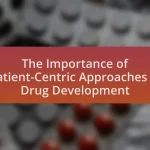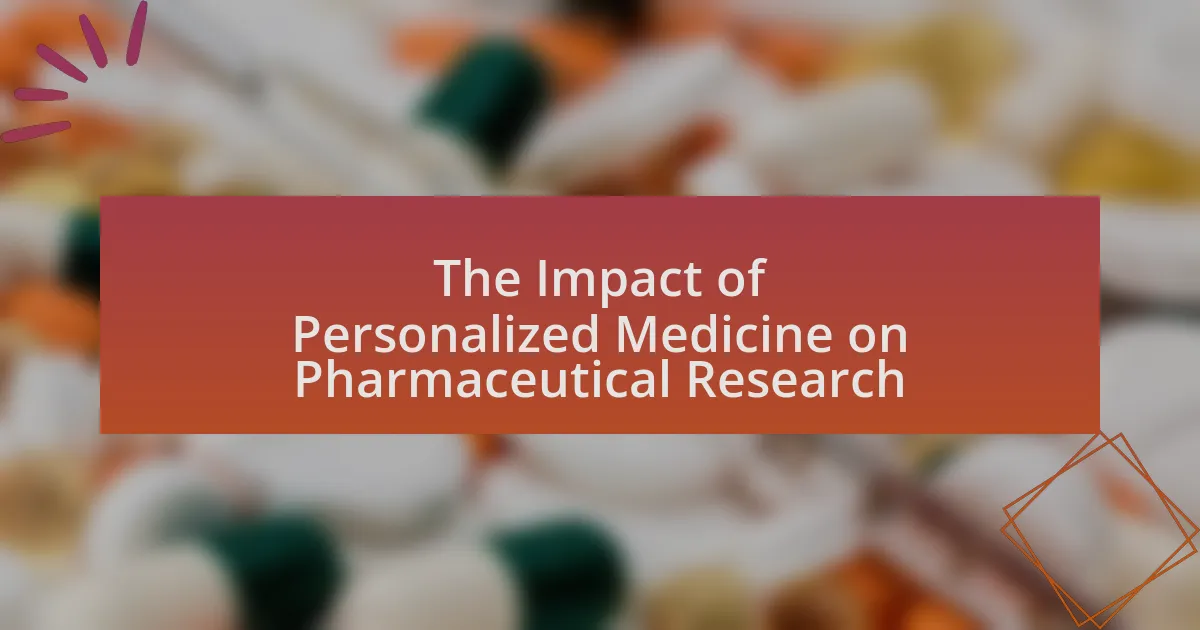The article focuses on strategies for effective drug repurposing, emphasizing the importance of leveraging existing clinical data, computational methods, and targeted clinical trials to identify new therapeutic uses for approved medications. It contrasts drug repurposing with traditional drug development, highlighting advantages such as reduced time and costs, while also addressing challenges like regulatory hurdles and intellectual property issues. Methodologies such as computational drug repositioning and network pharmacology are discussed, along with the critical role of clinical trials in validating repurposed drugs. Successful examples, particularly in oncology and rare diseases, illustrate the potential of repurposing to enhance patient outcomes and expedite access to therapies.
What are the key strategies for effective drug repurposing?
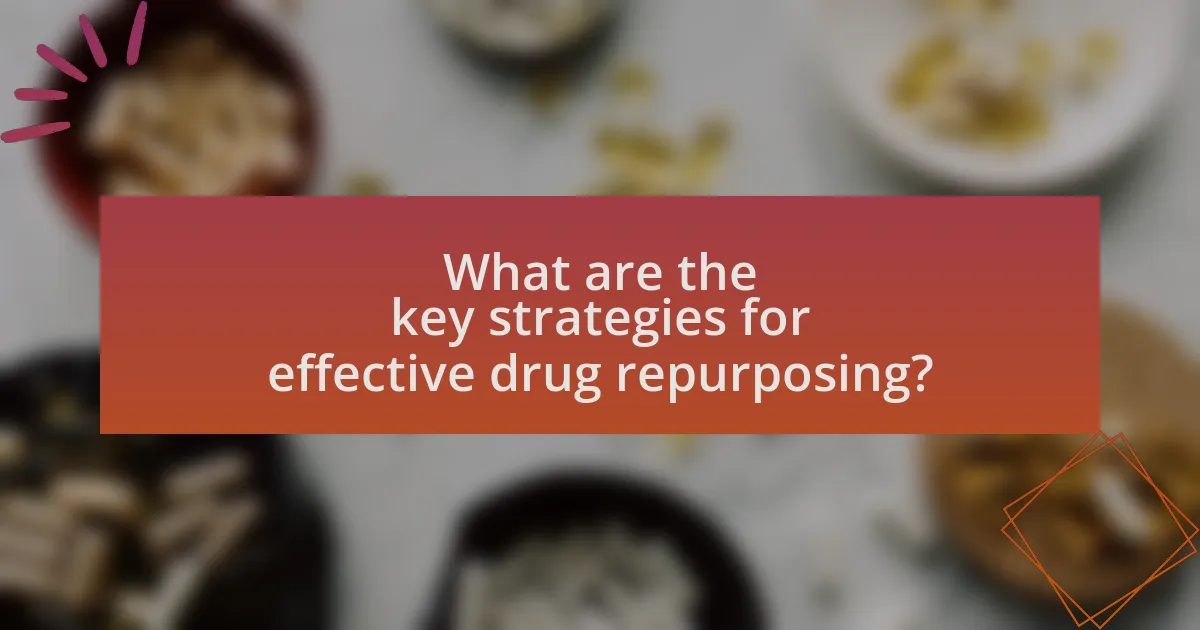
Key strategies for effective drug repurposing include leveraging existing clinical data, utilizing computational methods for drug-disease interaction predictions, and conducting targeted clinical trials. Leveraging existing clinical data allows researchers to identify potential new uses for approved drugs based on observed outcomes in patient populations. Computational methods, such as machine learning algorithms, can analyze large datasets to predict interactions between existing drugs and new therapeutic targets, enhancing the efficiency of the repurposing process. Targeted clinical trials are essential for validating the efficacy of repurposed drugs in new indications, ensuring that the findings are robust and applicable to specific patient groups. These strategies collectively streamline the drug development process and can significantly reduce the time and cost associated with bringing new therapies to market.
How does drug repurposing differ from traditional drug development?
Drug repurposing differs from traditional drug development primarily in its approach to identifying therapeutic uses for existing drugs rather than creating new compounds from scratch. Traditional drug development typically involves extensive research, including target identification, lead compound discovery, preclinical testing, and multiple phases of clinical trials, which can take over a decade and cost billions of dollars. In contrast, drug repurposing leverages existing safety and efficacy data of approved drugs, significantly reducing the time and cost associated with bringing a treatment to market. For example, the repurposing of thalidomide for multiple myeloma demonstrated that existing drugs could be effectively utilized for new indications, showcasing the potential for faster patient access to therapies.
What are the advantages of drug repurposing over new drug discovery?
Drug repurposing offers several advantages over new drug discovery, primarily including reduced development time and lower costs. Existing drugs have established safety profiles, which significantly shortens the clinical trial phases compared to new compounds that require extensive testing for safety and efficacy. For instance, the repurposing of thalidomide for multiple myeloma demonstrated that leveraging existing knowledge can lead to quicker therapeutic applications. Additionally, drug repurposing can address unmet medical needs more rapidly, as seen with the use of antiviral medications for COVID-19, which were identified and deployed much faster than traditional drug development timelines would allow.
What challenges are associated with drug repurposing?
Drug repurposing faces several challenges, including regulatory hurdles, intellectual property issues, and the need for extensive clinical validation. Regulatory hurdles arise because repurposed drugs must still undergo rigorous testing to ensure safety and efficacy for new indications, which can be time-consuming and costly. Intellectual property issues may complicate the process, as existing patents can limit the ability to develop and market repurposed drugs. Additionally, the need for extensive clinical validation means that researchers must conduct new trials, which can require significant resources and time, potentially delaying the availability of repurposed therapies to patients.
What methodologies are commonly used in drug repurposing?
Common methodologies used in drug repurposing include computational drug repositioning, high-throughput screening, and network pharmacology. Computational drug repositioning employs bioinformatics tools to analyze existing drug databases and predict new therapeutic uses based on molecular similarities and biological pathways. High-throughput screening allows researchers to test large libraries of compounds against specific disease models to identify potential repurposing candidates. Network pharmacology integrates various biological data to understand the interactions between drugs and their targets, facilitating the identification of new applications for existing medications. These methodologies have been validated through numerous studies, demonstrating their effectiveness in accelerating the drug repurposing process.
How do computational methods aid in identifying repurposing opportunities?
Computational methods aid in identifying repurposing opportunities by analyzing large datasets to uncover potential new uses for existing drugs. These methods utilize algorithms and machine learning techniques to evaluate biological data, chemical properties, and clinical outcomes, allowing researchers to predict interactions and efficacy in different therapeutic contexts. For instance, network pharmacology approaches can map drug-target interactions and identify off-target effects, which may reveal alternative therapeutic applications. Additionally, computational simulations can model disease pathways and drug mechanisms, facilitating the identification of candidates for repurposing based on shared biological targets or pathways.
What role do clinical trials play in the drug repurposing process?
Clinical trials are essential in the drug repurposing process as they provide the necessary framework to evaluate the safety and efficacy of existing drugs for new therapeutic indications. These trials systematically assess how well a repurposed drug performs in treating a different condition compared to standard treatments or placebos, ensuring that any new use is supported by robust clinical evidence. For instance, the repurposing of thalidomide for multiple myeloma involved extensive clinical trials that demonstrated its effectiveness, leading to its approval for this new indication. Thus, clinical trials validate the potential benefits of repurposed drugs, facilitating their integration into clinical practice.
What are the regulatory considerations for drug repurposing?
Regulatory considerations for drug repurposing include ensuring safety and efficacy, compliance with existing regulations, and navigating the approval process. The U.S. Food and Drug Administration (FDA) requires that any repurposed drug must demonstrate its safety and effectiveness for the new indication through clinical trials, which may vary in scale depending on the extent of the repurposing. Additionally, the regulatory pathway can differ based on whether the repurposed drug is classified as a new drug application (NDA) or a supplemental application for an existing drug. The FDA has also established mechanisms like the 505(b)(2) application, which allows for a more streamlined approval process by leveraging existing data from previous studies. These considerations are crucial for ensuring that repurposed drugs meet the necessary standards for public health and safety.
How do regulatory agencies view repurposed drugs compared to new drugs?
Regulatory agencies generally view repurposed drugs more favorably than new drugs due to their established safety profiles and existing data on efficacy. Repurposed drugs often require less extensive clinical trials, which can expedite the approval process, as seen in cases like the repurposing of thalidomide for multiple myeloma, where the FDA recognized its potential based on prior safety data. This streamlined pathway can lead to faster patient access to therapies, particularly in urgent situations like pandemics, where time is critical.
What are the implications of patent laws on drug repurposing?
Patent laws significantly impact drug repurposing by determining the exclusivity and financial incentives for pharmaceutical companies. These laws can either encourage or hinder the repurposing process; for instance, if a drug is still under patent protection, the original manufacturer retains exclusive rights, which may limit access for researchers seeking to explore new uses. Conversely, once a patent expires, generic manufacturers can enter the market, potentially increasing the availability of repurposed drugs and reducing costs. The balance between protecting innovation and fostering competition is crucial, as evidenced by the 2019 study published in the Journal of Pharmaceutical Sciences, which highlighted that patent expiration often leads to a surge in repurposing efforts, thereby enhancing therapeutic options for patients.
What are the most successful examples of drug repurposing?
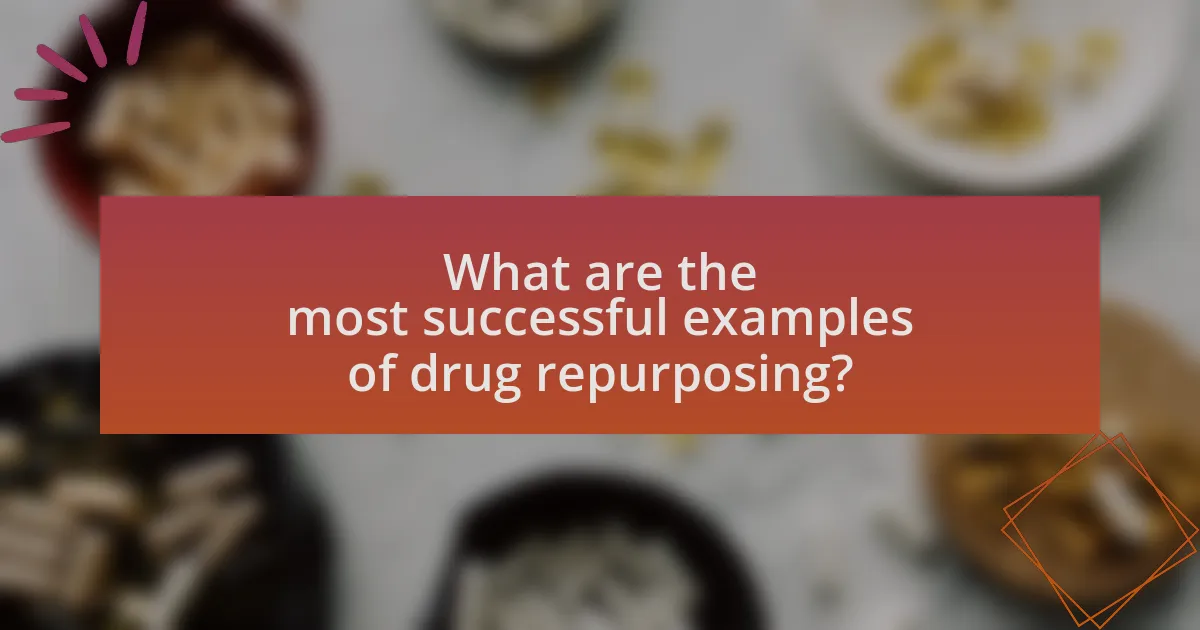
The most successful examples of drug repurposing include the use of thalidomide for multiple myeloma and the repurposing of sildenafil, originally developed for hypertension, to treat erectile dysfunction. Thalidomide, initially prescribed as a sedative, was found to have anti-inflammatory and anti-angiogenic properties, leading to its approval for multiple myeloma treatment in 2006. Sildenafil, originally tested for angina, was discovered to improve erectile function, resulting in its market release as Viagra in 1998. These cases illustrate the potential of drug repurposing to provide effective treatments for conditions beyond their original indications.
How has drug repurposing impacted specific diseases?
Drug repurposing has significantly impacted diseases such as cancer, malaria, and COVID-19 by enabling existing medications to be utilized for new therapeutic purposes. For instance, the anti-parasitic drug ivermectin, originally used for treating river blindness, has shown efficacy against malaria and has been investigated for its potential against COVID-19. Additionally, the cancer drug thalidomide, initially withdrawn due to safety concerns, has been repurposed to treat multiple myeloma and leprosy, demonstrating its effectiveness in these conditions. These examples illustrate how drug repurposing can accelerate treatment options and improve patient outcomes by leveraging established safety profiles and mechanisms of action.
What are notable cases of successful drug repurposing in oncology?
Notable cases of successful drug repurposing in oncology include the use of thalidomide for multiple myeloma and the repurposing of aspirin for colorectal cancer prevention. Thalidomide, originally developed as a sedative, was found to have anti-angiogenic properties that benefit multiple myeloma patients, leading to its approval for this indication in 2006. Aspirin, a common analgesic, has been shown in various studies to reduce the risk of colorectal cancer, with research indicating a 25% reduction in risk among regular users, prompting ongoing investigations into its use as a preventive therapy in oncology.
How has drug repurposing benefited patients with rare diseases?
Drug repurposing has significantly benefited patients with rare diseases by providing access to effective treatments that were originally developed for other conditions. This approach accelerates the availability of therapies, as existing drugs have already undergone safety and efficacy evaluations, reducing the time and cost associated with traditional drug development. For instance, the use of thalidomide, initially developed as a sedative, has been successfully repurposed to treat multiple myeloma and leprosy, demonstrating the potential of repurposed drugs to address unmet medical needs in rare diseases.
What lessons can be learned from past drug repurposing efforts?
Past drug repurposing efforts demonstrate the importance of leveraging existing safety data to expedite the development process. For instance, the successful repurposing of thalidomide for multiple myeloma highlighted how prior knowledge of a drug’s safety profile can facilitate quicker clinical trials. Additionally, the rapid repurposing of antiviral drugs during the COVID-19 pandemic, such as remdesivir, illustrated the need for flexible regulatory frameworks that allow for swift adaptation of existing therapies to new diseases. These examples underscore the value of interdisciplinary collaboration and the integration of real-world evidence in identifying potential new uses for established medications.
What factors contributed to the success of certain repurposed drugs?
The success of certain repurposed drugs is primarily attributed to their established safety profiles, existing pharmacological data, and the ability to quickly adapt to emerging health crises. Established safety profiles allow for faster regulatory approval processes, as seen with drugs like dexamethasone, which was repurposed for COVID-19 treatment due to its known safety and efficacy in reducing inflammation. Existing pharmacological data facilitates understanding of mechanisms of action, enabling researchers to identify potential new uses for existing drugs, exemplified by the use of the antiviral remdesivir, initially developed for Ebola, in treating COVID-19. Additionally, the urgent need for treatments during health emergencies accelerates research and funding, as demonstrated during the COVID-19 pandemic, where repurposed drugs were rapidly evaluated in clinical trials, leading to timely therapeutic options.
What common pitfalls should be avoided in future repurposing projects?
Common pitfalls to avoid in future drug repurposing projects include inadequate preclinical validation, overlooking regulatory requirements, and failing to engage with stakeholders. Inadequate preclinical validation can lead to ineffective or unsafe drug applications, as evidenced by the high failure rates in clinical trials when prior research is insufficient. Overlooking regulatory requirements can result in delays or rejections, as seen in cases where repurposed drugs did not meet the necessary guidelines set by agencies like the FDA. Lastly, failing to engage with stakeholders, including patients and healthcare providers, can lead to a lack of market acceptance and ultimately hinder the success of the repurposed therapy.
How can stakeholders maximize the potential of drug repurposing?
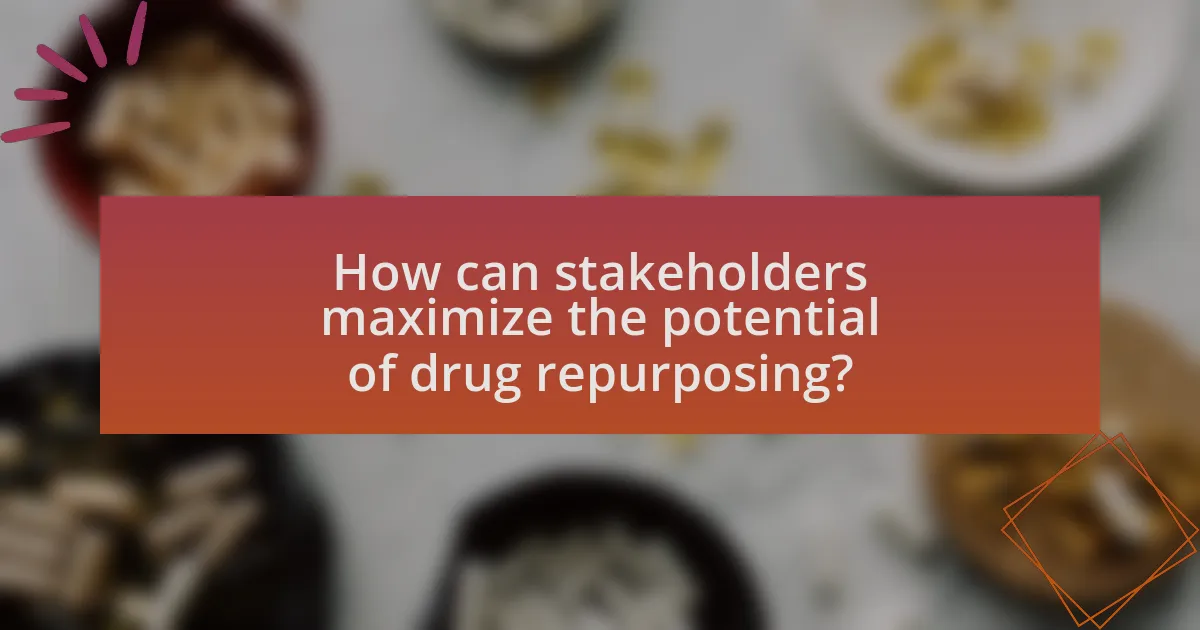
Stakeholders can maximize the potential of drug repurposing by fostering collaboration among researchers, pharmaceutical companies, and regulatory bodies. This collaboration enhances the sharing of data and resources, which accelerates the identification of new therapeutic uses for existing drugs. For instance, the FDA’s 2012 guidance on drug repurposing encourages the use of existing safety data to streamline the approval process, thereby reducing development time and costs. Additionally, stakeholders can leverage advanced computational methods and artificial intelligence to analyze existing drug databases, identifying promising candidates for repurposing more efficiently.
What collaborative approaches enhance drug repurposing efforts?
Collaborative approaches that enhance drug repurposing efforts include public-private partnerships, interdisciplinary research teams, and data-sharing initiatives. Public-private partnerships facilitate resource sharing and expertise exchange, which accelerates the identification of new therapeutic uses for existing drugs. Interdisciplinary research teams, comprising experts from various fields such as pharmacology, bioinformatics, and clinical medicine, foster innovative strategies and comprehensive analyses of drug mechanisms. Data-sharing initiatives, such as the OpenFDA and the Drug Repurposing Hub, provide access to vast datasets that enable researchers to identify potential repurposing opportunities more efficiently. These collaborative strategies have been shown to significantly increase the success rate and speed of drug repurposing projects, as evidenced by successful case studies like the repurposing of thalidomide for multiple myeloma.
How can partnerships between academia and industry facilitate repurposing?
Partnerships between academia and industry can facilitate repurposing by combining academic research expertise with industry resources and market knowledge. This collaboration allows for the identification of new therapeutic uses for existing drugs, leveraging academic findings to inform industry practices. For instance, academic institutions often conduct fundamental research that uncovers novel mechanisms of action for established drugs, while industry partners can provide the necessary funding, regulatory knowledge, and distribution channels to bring these repurposed therapies to market efficiently. A notable example is the collaboration between academic researchers and pharmaceutical companies during the COVID-19 pandemic, which accelerated the repurposing of existing antiviral drugs for treatment, demonstrating the effectiveness of such partnerships in achieving rapid therapeutic advancements.
What role do patient advocacy groups play in drug repurposing initiatives?
Patient advocacy groups play a crucial role in drug repurposing initiatives by providing a voice for patients and facilitating collaboration among stakeholders. These groups often mobilize patient communities to raise awareness about unmet medical needs, which can drive interest in repurposing existing drugs for new indications. For instance, advocacy organizations have successfully influenced research agendas and funding priorities, as seen in the case of the National Organization for Rare Disorders, which has supported repurposing efforts for rare diseases. Their involvement not only helps to identify potential therapeutic uses but also ensures that patient perspectives are integrated into the development process, ultimately enhancing the relevance and effectiveness of repurposed therapies.
What best practices should be followed for effective drug repurposing?
Effective drug repurposing requires a systematic approach that includes comprehensive data analysis, collaboration among multidisciplinary teams, and rigorous clinical validation. Comprehensive data analysis involves leveraging existing databases and literature to identify potential new uses for approved drugs, which can significantly reduce the time and cost associated with drug development. Collaboration among multidisciplinary teams, including pharmacologists, clinicians, and bioinformaticians, enhances the identification of viable repurposing candidates by integrating diverse expertise and perspectives. Rigorous clinical validation is essential to confirm the safety and efficacy of repurposed drugs in new indications, ensuring that findings are supported by robust clinical trial data. These practices are supported by successful examples, such as the repurposing of thalidomide for multiple myeloma, which demonstrates the potential of effective drug repurposing strategies.
How can data sharing improve the drug repurposing process?
Data sharing can significantly enhance the drug repurposing process by facilitating access to diverse datasets that reveal new therapeutic potentials for existing drugs. By pooling information from various research studies, clinical trials, and patient records, researchers can identify previously overlooked drug-disease relationships, accelerating the discovery of new applications for established medications. For instance, the sharing of genomic data has led to the identification of novel uses for drugs like thalidomide in treating multiple myeloma, showcasing how collaborative data efforts can lead to breakthroughs in treatment options.
What strategies can be employed to prioritize repurposing candidates?
To prioritize repurposing candidates, researchers can employ strategies such as utilizing computational drug repurposing methods, leveraging existing clinical data, and conducting systematic reviews of literature. Computational methods, including machine learning algorithms, can analyze large datasets to identify potential drug-disease interactions, thereby streamlining the selection process. Existing clinical data, such as electronic health records, can provide insights into off-label drug uses and patient outcomes, which can inform prioritization. Systematic reviews consolidate evidence from multiple studies, highlighting drugs with proven efficacy in similar conditions, thus guiding researchers toward the most promising candidates for repurposing.
What practical tips can researchers follow to succeed in drug repurposing?
Researchers can succeed in drug repurposing by systematically analyzing existing drug databases and leveraging computational methods to identify potential new uses for approved medications. Utilizing bioinformatics tools allows researchers to uncover novel drug-target interactions, while conducting thorough literature reviews can reveal previously overlooked therapeutic effects. Collaborating with clinical experts enhances the understanding of disease mechanisms and patient needs, facilitating the identification of suitable candidates for repurposing. Additionally, engaging in early-phase clinical trials can provide valuable insights into the efficacy of repurposed drugs, as evidenced by successful cases like the use of thalidomide for multiple myeloma after its initial approval for morning sickness.


